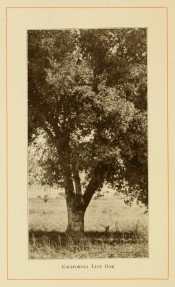Quercus agrifolia N
Fully-hard, spreading evergreen tree with ridged, grey or reddish-brown bark, glossy, elliptic leaves, to 7cm long, and solitary, slender, pointed acorns, to 3.5cm long. To 10m. [RHSE].
Horticultural & Botanical History
‘This fine western tree belongs to the black oak group, yet its acorns mature in one year, like those of white oaks. It is the only known black oak with that habit. It is properly classed with canyon live oak which has many characteristics of white oak, yet matures its acorns the second year. The two oaks with freakish fruit belong in California, and to some extent occupy the same range. California live oak is apparently making an effort to conform to the habit of other black oaks by producing two year acorns. It has not yet succeeded in doing so, but flowers occasionally appear in the fall, and young acorns set on the twigs. They drop during the winter, and it is not believed that any of them hang till the second season.
The range of this tree covers most of the California coast region but does not reach the great interior valleys. The tree is very common in the southwestern part of the state. It is called an evergreen, and some individuals deserve that reputation, but the leaves never remain long after the new crop appears. Frequently the old leaves do not wait for the new, and when they drop, the branches remain bare for a few weeks. The form of the leaf is not constant. Some have smooth margins, but the typical leaf is toothed like holly. One of the early names by which the tree was known was holly-leaved oak. The bark looks much like the bark of chestnut oak. It is bought for tanning purposes, but its principal use is to adulterate the bark of another oak (Quercus densiflora). Trees range in height from twenty-five to seventy-five feet, and from one foot to four in diameter. The trunks are very short, and seldom afford clear lengths exceeding eight feet, and often not more than four. Trees generally grow in the open, but when in thickets, the boles lengthen somewhat. They are of slow growth and live to old age.’ [Gibson – American Forest Trees p.307/1913].
‘A very pretty and well-marked species of oak. It was first found by Neé at Monterrey, and it is said also at Nutka.’ [HIP vol.4, t.377/1841]. Introduced to Britain in 1837. [JD].
History at Camden Park
Listed only in the 1857 catalogue [T.794/1857].
Notes
Quercus agrifolia Batt. & Trab. (1890) = Quercus ilex L. which see.
Published Feb 18, 2009 - 03:01 PM | Last updated Feb 03, 2010 - 02:53 PM
| Family | Fagaceae |
|---|---|
| Category | |
| Region of origin | Western USA |
| Synonyms | |
| Common Name | Californian live oak |
| Name in the Camden Park Record | Quercus agrifolia |
| Confidence level | high |


